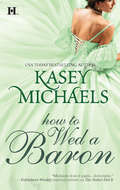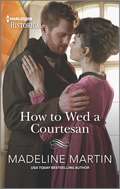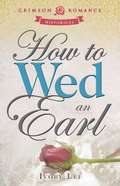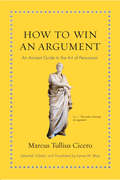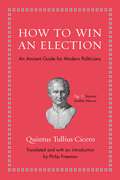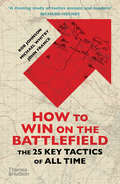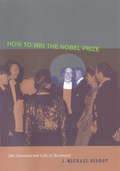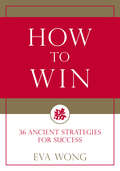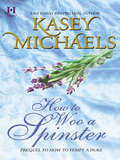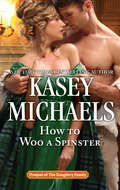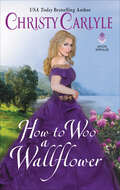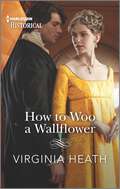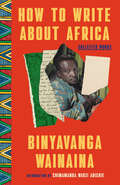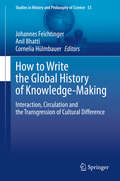- Table View
- List View
How to Wed a Baron
by Kasey MichaelsHe is but a pawn in someone else's game. With no choice but to do the prince regent's bidding, Justin Wilde must marry-marry!-a woman not of his own choosing. And for the man notoriously referred to as the Bad Baron, marriage is the last thing he wishes to consider. Especially when the bride has the beauty of an angel but the devil's own temper....Stunned to find herself married to a stranger, Alina vows to uncover the reason behind their forced union. Yet the more time she spends with her roguish husband, the less the past seems to matter. But when the truth behind their wedding at last emerges, will it strengthen their fragile bond-or shatter their lives forever?
How to Wed a Baron
by Kasey MichaelsHe is but a pawn in someone else's game. With no choice but to do the prince regent's bidding, Justin Wilde must marry-marry!-a woman not of his own choosing. And for the man notoriously referred to as the Bad Baron, marriage is the last thing he wishes to consider. Especially when the bride has the beauty of an angel but the devil's own temper....Stunned to find herself married to a stranger, Alina vows to uncover the reason behind their forced union. Yet the more time she spends with her roguish husband, the less the past seems to matter. But when the truth behind their wedding at last emerges, will it strengthen their fragile bond-or shatter their lives forever?
How to Wed a Courtesan: An entertaining Regency romance (The London School for Ladies #3)
by Madeline MartinFrom New York Times Bestselling Author Madeline MartinFrom courtesan…to society wife?When Evander, Earl of Westix, returns from the continent to claim his bride, he is shocked that the innocent vicar&’s daughter he once loved has become a notorious courtesan. But Lottie is so much more than the insult society hurls at her. She is resourceful and strong—after all, she&’s had to be to survive. Her charms are undeniable, but her heart is beyond his grasp. To win it will mean taking her from bedroom to ballroom… From Harlequin Historical: Your romantic escape to the past.The London School for LadiesBook 1: How to Tempt a DukeBook 2: How to Start a ScandalBook 3: How to Wed a Courtesan
How to Wed a Warrior
by Christy EnglishHe's the scourge of the Season...Reasons to quit London:1. It's not the Highlands.2. It will never be the Highlands.3. It's full of the bloody English.When his wild spitfire of a sister makes a scene by drawing a claymore in Hyde Park, Highlander Robert Waters knows something must be done. To forestall the inevitable scandal, he hires widowed Prudence Whittaker to teach his sister how to be a lady-never expecting to find unbridled passion beneath the clever Englishwoman's prim exterior.Mrs. Whittaker is a fraud. Born Lady Prudence Farthington, daughter of the ruined earl of Lynwood, she's never even been married. In order to make her way in the world, she has to rely on her wits and a web of lies...lies a sexy Highlander is all too close to unraveling. He swears he will possess her; she vows he will do nothing of the sort. Yet as passions heat, Prudence comes to realize the illicit pleasure that can be had in going toe-to-toe with a Scot.Broadswords and Ballrooms:How to Seduce a ScotHow to Wed a WarriorHow to Train Your HighlanderPraise for Christy English:"Grace Burrowes and Amanda Quick fans will enjoy the strong ladies in the latest fun read from the ascending English." -Booklist "With its quick and engaging characters, here's a pleasurable evening's escape." -RT Book Reviews
How to Wed an Earl
by Ivory LeiHaving regained his fortune, Lucas, Earl of Ravenstone, has to marry in order to keep it. Luckily, he won't have to search for a wife - he's known her name since their marriage was arranged in their youth. To fulfill his duty, he travels far from London Society to claim a fiancée who would no doubt be thrilled at the prospect of finally being able to use his name and become his countess.Penelope Maitland has already been using Lucas's name - to fend off her stepfamily's creditors. After wasting decades waiting for him, she reckons it's only fair she gets something out of her long-standing betrothal before she hears Lucas has married someone else.When they accidentally meet in a coaching inn, she finds herself fighting dangerous girlhood fantasies about marrying the man of her dreams who broke her heart with his apparent lack of interest. And Lucas finds that in order to keep his fortune, he will have to lose his heart to a woman who is tired of waiting for him.Sensuality Level: Sensual
How to Wed an Earl
by Ivory LeiHaving regained his fortune, Lucas, Earl of Ravenstone, has to marry in order to keep it. Luckily, he won’t have to search for a wife - he’s known her name since their marriage was arranged in their youth. To fulfill his duty, he travels far from London Society to claim a fiancée who would no doubt be thrilled at the prospect of finally being able to use his name and become his countess.Penelope Maitland has already been using Lucas’s name - to fend off her stepfamily’s creditors. After wasting decades waiting for him, she reckons it’s only fair she gets something out of her long-standing betrothal before she hears Lucas has married someone else.When they accidentally meet in a coaching inn, she finds herself fighting dangerous girlhood fantasies about marrying the man of her dreams who broke her heart with his apparent lack of interest. And Lucas finds that in order to keep his fortune, he will have to lose his heart to a woman who is tired of waiting for him.Sensuality Level: Sensual
How to Wed an Earl
by Ivory LeiHaving regained his fortune, Lucas, Earl of Ravenstone, has to marry in order to keep it. Luckily, he won’t have to search for a wife - he’s known her name since their marriage was arranged in their youth. To fulfill his duty, he travels far from London Society to claim a fiancée who would no doubt be thrilled at the prospect of finally being able to use his name and become his countess.Penelope Maitland has already been using Lucas’s name - to fend off her stepfamily’s creditors. After wasting decades waiting for him, she reckons it’s only fair she gets something out of her long-standing betrothal before she hears Lucas has married someone else.When they accidentally meet in a coaching inn, she finds herself fighting dangerous girlhood fantasies about marrying the man of her dreams who broke her heart with his apparent lack of interest. And Lucas finds that in order to keep his fortune, he will have to lose his heart to a woman who is tired of waiting for him.Sensuality Level: Sensual
How to Win Friends and Influence Enemies: Taking On Liberal Arguments with Logic and Humor
by Will WittPolitical commentator and media personality Will Witt gives young conservatives the ammunition they need to fight back against the liberal media.Popular culture in America today is dominated by the left. Most young people have never even heard of conservative values from someone their age, and if they do, the message is often bland and outdated. Almost every Hollywood actor, musician, media personality, and role model for young people in America rejects conservative values, and Gen Zs and millennials are quick to regurgitate these viewpoints without developing their own opinions on issues. So many young conservatives in America want to stand up for their beliefs in their classrooms, at their jobs, with their friends, or on social media, but they don&’t have the tools to do so. In How to Win Friends and Influence Enemies, Will Witt arms Gen Zs and millennials with the knowledge and skills to combat the leftist narrative they hear every day.
How to Win a Wallflower (Rebels with a Cause #3)
by Samara ParishA wallflower will put everything on the line . . . When John Barnesworth inherits unexpectedly, he abandons his solitude and returns to London to settle his brother's affairs, only to discover his estates are crumbling and he is now betrothed to his brother&’s unpleasant fiancée. Her dowry might save him from ruin, but at what cost? His only hope lies with the vivacious, charming Lady Charlotte Stirling, whose audacious solution to John's troubles might actually work. If only he can keep his feelings for her out of the equation . . . Lady Charlotte Stirling knows she can&’t fall for John. He&’s her brother&’s best friend, he&’s engaged to her mortal enemy, and he wants to return to America. Not to mention he&’d never survive in her bustling social life. She can, however, try to solve his money problem. But the closer she gets to ensuring his freedom, the harder it is to let him go . . .
How to Win an Argument: An Ancient Guide to the Art of Persuasion
by Marcus Tullius Cicero James M. MayAll of us are faced countless times with the challenge of persuading others, whether we're trying to win a trivial argument with a friend or convince our coworkers about an important decision. Instead of relying on untrained instinct--and often floundering or failing as a result--we'd win more arguments if we learned the timeless art of verbal persuasion, rhetoric. How to Win an Argument gathers the rhetorical wisdom of Cicero, ancient Rome's greatest orator, from across his works and combines it with passages from his legal and political speeches to show his powerful techniques in action. The result is an enlightening and entertaining practical introduction to the secrets of persuasive speaking and writing--including strategies that are just as effective in today's offices, schools, courts, and political debates as they were in the Roman forum.How to Win an Argument addresses proof based on rational argumentation, character, and emotion; the parts of a speech; the plain, middle, and grand styles; how to persuade no matter what audience or circumstances you face; and more. Cicero's words are presented in lively translations, with illuminating introductions; the book also features a brief biography of Cicero, a glossary, suggestions for further reading, and an appendix of the original Latin texts.Astonishingly relevant, this unique anthology of Cicero's rhetorical and oratorical wisdom will be enjoyed by anyone who ever needs to win arguments and influence people--in other words, all of us.
How to Win an Election: An Ancient Guide for Modern Politicians (Ancient Wisdom for Modern Readers)
by Quintus Tullius CiceroA primer on campaigning in ancient Rome that reads like a strategy memo from a modern political consultantHow to Win an Election is an ancient Roman guide for campaigning that is as up-to-date as tomorrow's headlines. In 64 BC when idealist Marcus Cicero, Rome's greatest orator, ran for consul (the highest office in the Republic), his practical brother Quintus decided he needed some no-nonsense advice on running a successful campaign. What follows in his short letter are timeless bits of political wisdom, from the importance of promising everything to everybody and reminding voters about the sexual scandals of your opponents to being a chameleon, putting on a good show for the masses, and constantly surrounding yourself with rabid supporters. Presented here in a lively and colorful new translation, with the Latin text on facing pages, this unashamedly pragmatic primer on the humble art of personal politicking is dead-on (Cicero won)—and as relevant today as when it was written.A little-known classic in the spirit of Machiavelli's Prince, How to Win an Election is required reading for politicians and everyone who enjoys watching them try to manipulate their way into office.
How to Win on the Battlefield: The 25 Key Tactics Of All Time
by John France Rob Johnson Mike WhitbyThe essential military tactics that have enabled commanders from Alexander the Great to General Giap to achieve victory on the battlefield. This groundbreaking book examines battle tactics that have achieved victory through the ages. Drawing on examples of battles on land, at sea, and in the air, the authors reveal the enduring value of each tactic in clear and compelling descriptions and analysis. How can you draw your enemy off-balance? When is the best moment to deliver a counterattack? What is the effect of shock action or defense in depth? This book shows how certain tactical concepts have stood the test of time. It illustrates how General Robert E. Lee, although heavily outnumbered, achieved a remarkable victory through an audacious flanking maneuver at Chancellorsville in 1863, and how the same bold move had been used effectively in Europe more than 600 years before by the king of France at Bouvines. It examines how Allied armies seized and retained the initiative through the airborne landings in Normandy in 1944, and how Soviet General Zhukov pierced enemy lines using Blitzkrieg tactics in Mongolia in 1939. The book features evocative photographs, illustrations, and paintings, and 28 specially commissioned battle plans.
How to Win the Nobel Prize: An Unexpected Life in Science (The Jerusalem-Harvard Lectures #7)
by J. Michael BishopIn 1989 Michael Bishop and Harold Varmus were awarded the Nobel Prize for their discovery that normal genes under certain conditions can cause cancer. In this book, Bishop tells us how he and Varmus made their momentous discovery. More than a lively account of the making of a brilliant scientist, How to Win the Nobel Prize is also a broader narrative combining two major and intertwined strands of medical history: the long and ongoing struggles to control infectious diseases and to find and attack the causes of cancer. Alongside his own story, that of a youthful humanist evolving into an ambivalent medical student, an accidental microbiologist, and finally a world-class researcher, Bishop gives us a fast-paced and engrossing tale of the microbe hunters. It is a narrative enlivened by vivid anecdotes about our deadliest microbial enemies--the Black Death, cholera, syphilis, tuberculosis, malaria, smallpox, HIV--and by biographical sketches of the scientists who led the fight against these scourges. Bishop then provides an introduction for nonscientists to the molecular underpinnings of cancer and concludes with an analysis of many of today's most important science-related controversies--ranging from stem cell research to the attack on evolution to scientific misconduct. How to Win the Nobel Prize affords us the pleasure of hearing about science from a brilliant practitioner who is a humanist at heart. Bishop's perspective will be valued by anyone interested in biomedical research and in the past, present, and future of the battle against cancer.
How to Win: 36 Ancient Strategies for Success
by Eva WongPotent advice on how to think and act strategically in business, politics, and relationships--drawn from classic Chinese military and political expertise.The ancient strategies of war and politics have much to offer us in navigating the complicated challenges we face today--and to help us wisely and effectively meet our business, political, and relational goals. Here, eminent Chinese scholar and Taoist teacher Eva Wong unpacks the wisdom of The Thirty-Six Strategies, a collection of advice encoded in sayings, steeped in Chinese history and culture. She explores strategies attributed to renowned military philosophers such as Sun Tzu and Zhuge Liang (aka "The Sleeping Dragon"), along with other less-known advisors, that were implemented during three of the most chaotic eras of Chinese history--the Spring and Autumn Period, the Warring States Period, and the Three Kingdoms. Covering three categories of strategy--proactive, reactive, and desperate--Wong expertly connects the words of ancient military philosophers with timeless advice, as useful today as it was in the Tang dynasty (618-906) when this collection was originally gathered. In Chinese military philosophy and political theory, the thirty-six strategies are considered "yin" or "shadow" in nature, meaning that they operate best in darkness and concealment. As Wong writes, "Desperate times call for desperate measures, and since the thirty-six strategies rose out of times of war and conflict, it is inevitable that they were used to win wars, triumph over opponents, take advantage of situations, and survive when defeat is imminent."
How to Woo a Reluctant Lady: The Hellions Of Halstead Hall 3 (The Hellions of Halstead Hall #3)
by Sabrina JeffriesThe third sizzling romance in the Hellions of Hallstead Hall series, from New York Times bestselling author Sabrina Jeffries, follows a fiercely independent woman as she schemes to avoid an arranged marriage...but she may lose her heart in the process.Lady Minerva Sharpe&’s grandmother has a life-changing ultimatum for her inheritance—get married. But Lady Minerva believes she&’s come up with the perfect plan—embark on a fake engagement to a notorious rogue. Surely her grandmother would rather release her inheritance than have her married to a scoundrel. She just has to find one to play the part. Luckily, there&’s the wild barrister Giles Masters, the same man who has haunted her thoughts since he kissed her on her nineteenth birthday. Of course, she has no intention of falling for such a rake, much less marrying him. But soon, their fake betrothal leads to very real desire. An untputdownable romance, How to Woo a Reluctant Lady &“is richly imbued with steamy passion, deftly spiced with dangerous intrigue, and neatly tempered with just the right amount of tart wit&” (Booklist).
How to Woo a Spinster
by Kasey MichaelsHow to Woo a Spinster -- a Daughtry family prequelStill unmarried at twenty-eight, Lady Emmaline Daughtry has resigned herself to spinsterhood. Then Captain John Alistair arrives at her door--the very image of the perfect lover of her most private dreams. But can a man with a secret and a woman who's never known love find happiness when they least expect to?"Michaels has done it again. . . Witty dialogue peppers a plot full of delectable details exposing the foibles and follies of the age. " -- Publishers Weekly on The Butler Did It (starred review)
How to Woo a Spinster
by Kasey MichaelsHow to Woo a Spinster -- a Daughtry family prequelStill unmarried at twenty-eight, Lady Emmaline Daughtry has resigned herself to spinsterhood. Then Captain John Alistair arrives at her door--the very image of the perfect lover of her most private dreams. But can a man with a secret and a woman who's never known love find happiness when they least expect to?"Michaels has done it again... Witty dialogue peppers a plot full of delectable details exposing the foibles and follies of the age." -- Publishers Weekly on The Butler Did It (starred review)
How to Woo a Spinster
by Kasey MichaelsHow to Woo a Spinster -- a Daughtry family prequelStill unmarried at twenty-eight, Lady Emmaline Daughtry has resigned herself to spinsterhood. Then Captain John Alistair arrives at her door--the very image of the perfect lover of her most private dreams. But can a man with a secret and a woman who's never known love find happiness when they least expect to?"Michaels has done it again... Witty dialogue peppers a plot full of delectable details exposing the foibles and follies of the age." -- Publishers Weekly on The Butler Did It (starred review)
How to Woo a Spinster
by Kasey Michaels"Kasey Michaels aims for the heart and never misses." --New York Times bestselling author Nora Roberts Still unmarried at twenty-eight, Lady Emmaline Daughtry has resigned herself to spinsterhood. Then Captain John Alistair arrives at her door--the very image of the perfect lover of her most private dreams. But can a man with a secret and a woman who's never known love find happiness when they least expect to? Don't miss a chance to re-read the enchanting prequel novella to the delectable Daughtry Families series by New York Times bestselling author Kasey Michaels! Originally published in 2009.
How to Woo a Wallflower (Romancing the Rules #3)
by Christy CarlyleA not-quite-heiress takes on a publishing job—and an insufferable boss—in a novel by a USA Today–bestselling author and “historical romance lover’s dream” (Tessa Dare, author of The Duchess Deal). Clarissa Ruthven was born to be a proper lady, but she’s never wanted to live up to the expectations her late father set. Determined to use her inheritance to help the less fortunate women of Victorian London, she’s devastated to learn she won’t be inheriting anything until she marries—a fate she has no interest in. Unwilling to let go of her plans, Clary works at Ruthven Publishing for Gabriel Adamson, a man who’s always hated her. She’s always returned the feeling. But as she begins to turn her family’s publishing company upside down, she finds herself unable to forget her handsome boss.Gabriel Adamson believes in order. He certainly doesn’t believe Clary should be sticking her nose in the publishing company, and she definitely has no business invading his every thought. But Gabe soon finds he can’t resist Clary’s sense of freedom or her passionate kisses and starts to crave everything she’s willing to give him. And when his dark past comes back to haunt him, he’ll do anything to ensure Clary isn’t hurt . . . even if it means giving up the only woman he’s ever loved.Praise for the novels of Christy Carlyle“A charming Victorian romance.” —Kirkus Reviews“I absolutely adore Christy Carlyle.” —Lorraine Heath, New York Times–bestselling author of In Bed with the Devil
How to Woo a Wallflower (Society's Most Scandalous #1)
by Virginia HeathAn entertaining, sexy Regency romanceHe could have any debExcept his best friend&’s sister…Jasper, the Earl of Beaufort, hasn&’t seen Lady Harriet Fitzroy since her serious riding accident. She has grown into a kind, spirited woman, whose sinful smile plays havoc with his jaded emotions! Hattie&’s family disapprove of Jasper&’s rakish past, but when she risks her reputation to help him, the least he can do is pull her from the wallflower chairs and out of the shadows…From Harlequin Historical: Your romantic escape to the past.Society''s Most ScandalousBook 1: How to Woo a Wallflower by Virginia HeathBook 2: How to Cheat the Marriage Mart by Millie AdamsBook 3: How to Survive a Scandal by Christine Merrill
How to Write About Africa: Collected Works
by Binyavanga WainainaFrom one of Africa&’s most influential and eloquent essayists, a posthumous collection that highlights his biting satire and subversive wisdom on topics from travel to cultural identity to sexuality&“A fierce literary talent . . . [Wainaina] shines a light on his continent without cliché.&”—The Guardian&“Africa is the only continent you can love—take advantage of this. . . . Africa is to be pitied, worshipped, or dominated. Whichever angle you take, be sure to leave the strong impression that without your intervention and your important book, Africa is doomed.&”Binyavanga Wainaina was a pioneering voice in African literature, an award-winning memoirist and essayist, and a gatherer of literary communities. Before his tragic death in 2019 at the age of forty-seven, he won the Caine Prize for African Writing and was named one of Time&’s 100 Most Influential People. His wildly popular essay &“How to Write About Africa,&” an incisive and unapologetic piece exposing the harmful and racist ways Western media depicts Africa with implicit bias and subjective clichés, changed the game for African writers and helped set the stage for a new generation of authors, from Chimamanda Ngozi Adichie to Yaa Gyasi. When Wainaina published a &“lost chapter&” of his 2011 memoir as an essay called &“I Am a Homosexual, Mum,&” which imagines coming out to his mother, he became a voice for the queer African community as well, adding a new layer to how African sexuality is perceived.How to Write About Africa collects these powerful pieces in a lively and imaginative set of essays about sexuality, art, history, and contemporary Africa. Wainaina&’s writing is playful, robust, generous, and full-bodied. He describes the modern world with sensual, emotional, and psychological detail, giving us a full-color view of a country and continent. These works present a portrait of a giant in African literature who left a tremendous legacy.
How to Write About the Holocaust: The Postmodern Theory of History in Praxis (Routledge Approaches to History)
by Theodor PelekanidisHow to Write About the Holocaust is a contribution to ongoing debates in historiography and Holocaust studies. More specifically, it combines the theoretical framework that has developed in historiography in the last half a century with the demands of Holocaust representation. The first part of the book analyzes the newest trends in theory of history, focusing especially on postmodernism, starting from the works of the American historian and theorist Hayden White and tracing the genealogy of the postmodern influence in history both from an epistemological and from a political perspective. The second part continues by incorporating these theoretical developments into specific written examples on the Holocaust. By analyzing major works about it, including Saul Friedländer’s and Dan Stone’s histories of the Holocaust, the book attempts to answer questions like: what is the most appropriate way to write about the Holocaust and what can theory teach us about the practice of history? To conclude, the volume explores the connection between history and literature and asks if the distinction between fact and fiction has become outdated.
How to Write the Global History of Knowledge-Making: Interaction, Circulation and the Transgression of Cultural Difference (Studies in History and Philosophy of Science #53)
by Johannes Feichtinger Anil Bhatti Cornelia HülmbauerThis multidisciplinary collection of essays provides a critical and comprehensive understanding of how knowledge has been made, moved and used, by whom and for what purpose. To explain how new knowledge emerges, this volume offers a two-fold conceptual move: challenging both the premise of insurmountable differences between confined, autarkic cultures and the linear, nation-centered approach to the spread of immutable stocks of knowledge. Rather, the conceptual focus of the book is on the circulation, amalgamation and reconfiguration of locally shaped bodies of knowledge on a broader, global scale. The authors emphasize that the histories of interaction have been made less transparent through the study of cultural representations thus distorting the view of how knowledge is actually produced.Leading scholars from a range of fields, including history, philosophy, social anthropology and comparative culture research, have contributed chapters which cover the period from the early modern age to the present day and investigate settings in Africa, Asia, and Europe. Their particular focus is on areas that have largely been neglected until now. In this work, readers from many disciplines will find new approaches to writing the global history of knowledge-making, especially historians, scholars of the history and philosophy of science, and those in culture studies.
How to be Happy Though Married
by Old BooksThe bounteous pleasures of married life have been endured by stoical, ingenious men and women for millennia. 'How to be Happy Though Married' is a compendium of their hard-won wisdom, offering advice for any conceivable conjugal conundrum, from the potential of a wife to wander (you might consider stealing her shoes, a la the Ancient Greeks) to the avoidance of a drunk husband's amorous advances. Why suffer or rejoice alone when this book revealing the advice, observations and witty rejoinders of Jane Austen, Plutarch, Shakespeare, Trollope and Einstein could be your constant companion?
